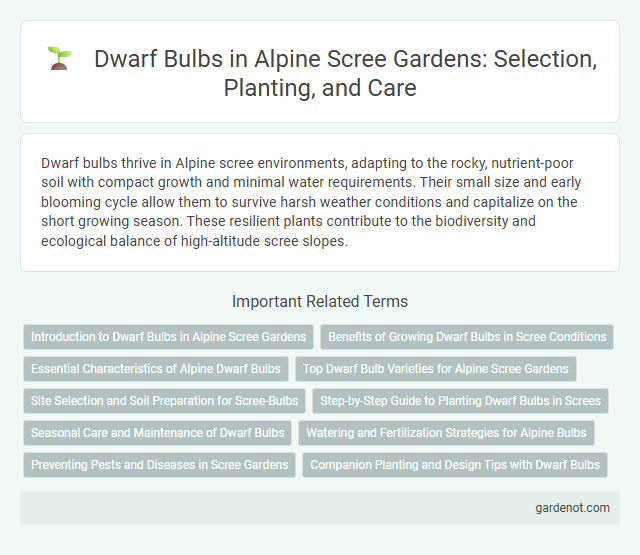Dwarf bulbs thrive in Alpine scree environments, adapting to the rocky, nutrient-poor soil with compact growth and minimal water requirements. Their small size and early blooming cycle allow them to survive harsh weather conditions and capitalize on the short growing season. These resilient plants contribute to the biodiversity and ecological balance of high-altitude scree slopes.
Introduction to Dwarf Bulbs in Alpine Scree Gardens
Dwarf bulbs in alpine scree gardens thrive due to their compact size and ability to adapt to harsh, rocky environments with well-drained soil. Species like snowdrops, crocuses, and miniature tulips offer early spring blooms that enhance the biodiversity and visual appeal of scree gardens. Their low-maintenance nature and resilience to cold alpine conditions make them ideal for sustainable succulent planting in high-altitude landscapes.
Benefits of Growing Dwarf Bulbs in Scree Conditions
Dwarf bulbs thrive in alpine scree due to their compact size and rapid growth, making them ideal for rocky, well-drained soils with minimal nutrients. Their ability to withstand harsh conditions enhances biodiversity by providing early-season nectar for pollinators and stabilizing loose scree substrates against erosion. Cultivating dwarf bulbs in scree environments promotes sustainable gardening practices and supports resilient alpine ecosystems.
Essential Characteristics of Alpine Dwarf Bulbs
Alpine dwarf bulbs exhibit compact growth forms with bulbs typically less than 2 cm in diameter, adapted to thrive in shallow, rocky soils of scree habitats. These bulbs display early spring flowering cycles, crucial for maximizing short growing seasons in high-altitude environments. Their essential characteristics include robust cold hardiness, efficient nutrient storage, and the ability to regenerate rapidly after harsh winters.
Top Dwarf Bulb Varieties for Alpine Scree Gardens
Top dwarf bulb varieties for alpine scree gardens include the miniature Crocus chrysanthus, renowned for its vibrant yellow blooms and early spring emergence. Muscari armeniacum, or grape hyacinth, thrives in well-drained scree with dense clusters of deep blue flowers that attract pollinators. Species such as Narcissus cantabricus offer compact growth and fragrant white blossoms, making them ideal for rocky, nutrient-poor alpine environments.
Site Selection and Soil Preparation for Scree-Bulbs
Dwarf bulbs thrive in scree environments with well-drained, gritty soils that prevent waterlogging and mimic their natural alpine habitat. Site selection should prioritize exposed, south-facing slopes that provide ample sunlight and swift drying conditions to avoid bulb rot in cold, wet seasons. Soil preparation involves incorporating coarse sand or fine gravel to enhance drainage and maintain the porous structure essential for healthy root development in scree-bulb cultivation.
Step-by-Step Guide to Planting Dwarf Bulbs in Screes
Planting dwarf bulbs in alpine scree requires preparing well-drained, gritty soil that mimics their natural habitat for optimal growth. Position bulbs such as crocus, snowdrops, and miniature irises at a depth approximately two to three times their height, spacing them 3 to 5 inches apart to ensure proper airflow and prevent rot. Water sparingly after planting and apply a light mulch of gravel to maintain soil moisture while avoiding excessive dampness, promoting healthy root development in scree environments.
Seasonal Care and Maintenance of Dwarf Bulbs
Dwarf bulbs in alpine scree require well-drained soil and minimal watering during dormancy in summer to prevent rot. They benefit from a light mulch in late autumn to protect against frost while allowing air circulation. Regular removal of spent foliage and dead flowers promotes healthy growth and prepares the bulbs for the next blooming season.
Watering and Fertilization Strategies for Alpine Bulbs
Dwarf bulbs in alpine scree environments require careful watering strategies to mimic their natural conditions, ensuring soil remains moist but well-drained to prevent rot. Fertilization should be minimal, using a balanced, low-nitrogen fertilizer applied sparingly during the active growing season to promote healthy growth without encouraging excessive foliage. Monitoring soil moisture and nutrient levels regularly supports optimal bulb development and flowering.
Preventing Pests and Diseases in Scree Gardens
Dwarf bulbs in alpine scree gardens benefit from well-drained, gritty soil that mimics their natural rocky habitat, minimizing moisture-related diseases. Regular inspection for common pests such as aphids and bulb mites helps prevent infestations before they cause significant damage. Applying organic mulch and ensuring adequate air circulation reduces fungal infections, maintaining healthy growth in these specialized garden environments.
Companion Planting and Design Tips with Dwarf Bulbs
Dwarf bulbs thrive alongside low-growing companion plants like mosses, sedums, and alpine grasses, creating a textured, colorful scree garden that mimics natural alpine environments. For effective design, cluster bulbs in groups to enhance visual impact and intersperse with hardy groundcovers to retain moisture and suppress weeds. Positioning dwarf bulbs in well-drained, rocky soil ensures optimal growth while maintaining the rugged aesthetic characteristic of alpine scree habitats.
Dwarf bulb Infographic

 gardenot.com
gardenot.com